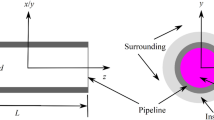Abstract
Heat transfer and pressure drop characteristics of a set of pin-fins with uniform heat flux were investigated experimentally and numerically. Test set-up was designed to assess the effects of mass flow rate, fin height, and fin density on convection heat transfer and pressure drop. In the numerical investigation, the flow field of various design parameters of the heat sink was simulated. It was found that heat sinks having fin heights of 20 and 30 mm operated at a lower Reynolds number reached minimum value for thermal resistance when the fin density 10 × 10. Which means it is the optimum number of fins for this case. Also, friction factor increased with a decrease in the bypass flow area or inter-fin distance spacing and using perforated fins reduced the pressure losses and thermal resistance for all studied cases.












Similar content being viewed by others
Abbreviations
- Dhd :
-
Duct hydraulic diameter (m)
- E:
-
Total energy per unit mass (J/kg)
- H:
-
Fin height (m)
- L:
-
Heat sink foot print length (m)
- N:
-
Number of fins
- P1 :
-
Channel inlet pressure (N/m2)
- PL :
-
Non-dimensional pitch = (a + b)/a
- Q:
-
Heat input (W)
- Rth :
-
Total thermal resistance (K/W)
- ReD :
-
Reynolds number using Dh
- Vd :
-
Duct velocity (m/s)
- Sg :
-
Entropy generation minimization
- h:
-
Heat transfer coefficient (W/m2 K)
- b:
-
Fin spacing (m)
- a:
-
Fin side thickness (m)
- y + :
-
Dimensionless wall distance
- ε:
-
Turbulent dissipation rate (m2/s5)
- μ:
-
Absolute viscosity (Pa s)
- β:
-
Open area ratio (%)
- ρ:
-
Density (kg/m5)
- ∆P:
-
Pressure drop across heat sink (N/m2)
- B:
-
Base plate
- Dh :
-
Hydraulic diameter
References
Kays WM (1953) Pin fin heat exchanger surfaces, Department of Mechanical Engineering, Stanford University; Office of Naval Research, US
Kays WM, Crawford ME, Weigand B (1993) Convective heat and mass transfer. McGraw-Hill, New York
Peng Y (1983) Heat transfer and friction loss characteristics of pin fin cooling configuration. In: 28th international gas turbine conference and exhibit
Armstrong J, Winstanley D (1987) A review of staggered array pin fin heat transfer for turbine cooling applications. In: 32nd international gas turbine conference and exhibition
Azar K, Tavassoli B (2003) How much heat can be extracted from a heat sink? Electron Cool 9:30–37
Sparrow E, Ramsey J (1978) Heat transfer and pressure drop for a staggered wall-attached array of cylinders with tip clearance. Int J Heat Mass Transf 21:1369–1378
Sparrow E, Ramsey J, Altemani C (1980) Experiments on in-line pin fin arrays and performance comparisons with staggered arrays. J Heat Transf 102:44
Metzger D, Berry R, Bronson J (1982) Developing heat transfer in rectangular ducts with staggered arrays of short pin fins. J Heat Transf 104:700
Simoneau R, VanFossen G Jr (1984) Effect of location in an array on heat transfer to a short cylinder in crossflow. J Heat Transf 106:42–48
Matsumoto R, Kikkawa S, Senda M (1997) Effect of pin fin arrangement on endwall heat transfer. JSME Int J Ser B 40:142–151
Chen Z, Li Q, Meier D, Warnecke H-J (1997) Convective heat transfer and pressure loss in rectangular ducts with drop-shaped pin fins. Heat Mass Transf 33:219–224
Sahiti N, Lemouedda A, Stojkovic D, Durst F, Franz E (2006) Performance comparison of pin fin in-duct flow arrays with various pin cross-sections. Appl Therm Eng 26:1176–1192
Tanda G (2001) Heat transfer and pressure drop in a rectangular channel with diamond-shaped elements. Int J Heat Mass Transf 44:3529–3541
Chyu M, Hsing Y, Natarajan V (1998) Convective heat transfer of cubic fin arrays in a narrow channel. J Turbomach 120:362–367
Al-Jamal K, Khashashneh H (1998) Experimental investigation in heat transfer of triangular and pin fin arrays. Heat Mass Transf 34:159–162
Şara O, Yapıcı S, Yılmaz M, Pekdemir T (2001) Second law analysis of rectangular channels with square pin-fins. Int Commun Heat Mass Transf 28:617–630
Boesmans B, Christiaens F, Berghmans J, Beyne E (1994) Design of an optimal heat-sink geometry for forced convection air cooling of Multi-Chip Modules. In: Thermal management of electronic systems. Springer, Berlin, pp 267–276
Kondo Y, Matsushima H, Komatsu T (2000) Optimization of pin-fin heat sinks for impingement cooling of electronic packages. J Electron Packag 122:240
Dogruoz MB, Urdaneta M, Ortega A (2005) Experiments and modeling of the hydraulic resistance and heat transfer of in-line square pin fin heat sinks with top by-pass flow. Int J Heat Mass Transf 48:5058–5071
Khan WA, Yovanovich M, Culham J (2006) Optimization of microchannel heat sinks using entropy generation minimization method. In: Semiconductor thermal measurement and management symposium, 2006 IEEE twenty-second annual IEEE IEEE, pp 78–86
Shaeri M, Yaghoubi M (2009) Thermal enhancement from heat sinks by using perforated fins. Energy Convers Manag 50:1264–1270
Mei D, Lou X, Qian M, Yao Z, Liang L, Chen Z (2014) Effect of tip clearance on the heat transfer and pressure drop performance in the micro-reactor with micro-pin-fin arrays at low Reynolds number. Int J Heat Mass Transf 70:709–718
Ismail MF, Hasan MN, Saha SC (2014) Numerical study of turbulent fluid flow and heat transfer in lateral perforated extended surfaces. Energy 64:632–639
Ismail MF, Reza M, Zobaer M, Ali M (2013) Numerical investigation of turbulent heat convection from solid and longitudinally perforated rectangular fins. Proced Eng 56:497–502
Fluent Guide AFUs (2010) Release 13.0. ANSYS. Inc, Canonsburg, PA
Author information
Authors and Affiliations
Corresponding author
Rights and permissions
About this article
Cite this article
Elsayed, M.L., Mesalhy, O. Studying the performance of solid/perforated pin-fin heat sinks using entropy generation minimization. Heat Mass Transfer 51, 691–702 (2015). https://doi.org/10.1007/s00231-014-1451-9
Received:
Accepted:
Published:
Issue Date:
DOI: https://doi.org/10.1007/s00231-014-1451-9




